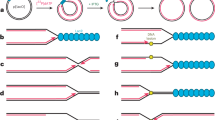Abstract
The ETS gene products are a family of transcriptional regulatory proteins that contain a highly conserved and structurally unique DNA binding domain, termed the ETS domain. Several ETS proteins bind to DNA as monomers, however it has been shown that the DNA binding activity is enhanced or modulated in the presence of other factors. By differential display and whole genome PCR techniques, we have recently shown that the Erg1 gene is a target for ETS proteins. The Egr1 promoter contains multiple ETS binding sites, three of which exist as parts of two serum response elements (SREI and SREII). The SRE is a cis-element that regulates the expression of many growth factor responsive genes. ELK1 and SAP1a have been shown to form ternary complexes with SRF on the SRE located in the c-fos promoter. Similarly, we examined whether the ELK1, SAP1a, FLI1, EWS-FLI1, ETS1, ETS2, PEA3 and PU.1 proteins can form ternary complexes with SRF on the Egr1 SREI and II. Our results demonstrate that indeed ELK1, SAP1a, FLI1 and EWS-FLI1 are able to form ternary complexes with SRF on Egr1 SREs. In addition, ELK1 and SAP1a can also form quarternary complexes on the Egr1 SREI. However, the proteins ETS1, ETS2, PEA3 and PU.1 were unable to form ternary complexes with SRF on either the Egr1 or c-fos SREs. Our data demonstrate that FLI1 and EWS-FLI1 constitute new members of a subgroup of ETS proteins that can function as ternary complex factors and further implicate a novel function for these ETS transcription factors in the regulation of the Egr1 gene. By amino acid sequence comparison we found that, in fact, 50% of the amino acids present in the B-box of SAP1a and ELK1, which are required for interaction with SRF, are identical to those present in both FLI1 (amino acids 231 – 248) and EWS-FLI1 proteins. This B-box is not present in ETS1, ETS2, PEA3 or PU.1 and these proteins were unable to form ternary complexes with SRF and Egr1-SREs or c-fos SRE. Furthermore, deletion of 194 amino terminal amino acids of FLI1 did not interfere with its ability to interact with SRF, in fact, this truncation increased the stability of the ternary complex. The FLI1 protein has a unique R-domain located next to the DNA binding region. This R-domain may modulate the interaction with SRF, providing a mechanism that would be unique to FLI1 and EWS-FLI1, thus implicating a novel function for these ETS transcription factors in the regulation of the Egr1 gene.
This is a preview of subscription content, access via your institution
Access options
Subscribe to this journal
Receive 50 print issues and online access
$259.00 per year
only $5.18 per issue
Buy this article
- Purchase on Springer Link
- Instant access to full article PDF
Prices may be subject to local taxes which are calculated during checkout
Similar content being viewed by others
Author information
Authors and Affiliations
Rights and permissions
About this article
Cite this article
Watson, D., Robinson, L., Hodge, D. et al. FLI1 and EWS-FLI1 function as ternary complex factors and ELK1 and SAP1a function as ternary and quaternary complex factors on the Egr1 promoter serum response elements. Oncogene 14, 213–221 (1997). https://doi.org/10.1038/sj.onc.1200839
Received:
Revised:
Accepted:
Issue Date:
DOI: https://doi.org/10.1038/sj.onc.1200839
Keywords
This article is cited by
-
The FLI portion of EWS/FLI contributes a transcriptional regulatory function that is distinct and separable from its DNA-binding function in Ewing sarcoma
Oncogene (2021)
-
ELK1
AfCS-Nature Molecule Pages (2011)
-
Suppression of Egr-1 transcription through targeting of the serum response factor by oncogenic H-Ras
The EMBO Journal (2006)
-
Curcumin inhibits human colon cancer cell growth by suppressing gene expression of epidermal growth factor receptor through reducing the activity of the transcription factor Egr-1
Oncogene (2006)
-
EWS-FLI1 target genes recovered from Ewing's sarcoma chromatin
Oncogene (2005)



